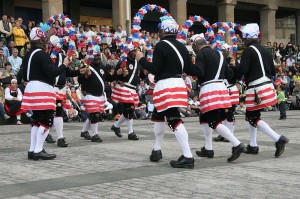The Britannia Coconut Dancers
From the town of Bacup with blackened faces and unusual costumes comes a unique folk dance troup. The team dances several garland dances once common as part of rushbearing festivals around the area, but also a “nut dance” of which they now seem to be the sole surviving example.
Whilst the clogs shirt and britches are traditional Lancashire, the white and red hooped skirt and white hat/turban seem more exotic in origin.
While Morris Dancing is rumoured to have been derived from the dances of the Moors, the African tribe that conquered large parts of Spain, Portugal and Southern France. The tradition danced by the Britannia dancers seems to have a more definite link. It is rumoured to have been taught to Cornish tin miners by Moors who came to this country and found employment in the mines. When the work in Cornwall became scarce during the 18th & 19th centuries some of the Cornish miners came to the North-West to work in the mines and quarries and brought the tradition with them.

Tunstead Mill Nutters 1907
In recent times, the blackening of the dancer’s faces has been called into question and while there may be some distant reference to race as related in the above story, I’d like to think that, if it was, it was more an appreciation that everyone was the same colour when they came out from the mine at the end of a hard day’s work.
Another possibility is that the Nut Dance is superstitious in nature. Some of the actions of this particular dance seem to depict listening for sounds that could warn of the danger of tunnels collapsing. In a more primitive age such disasters would have been put down to malevolent spirits which would often be “scared away” by such rituals and the men may have blacked their faces so they wouldn’t be recognised by them and become a target of supernatural retribution.
The “nuts” themselves are small wooden disks worn on the hands, knees and belts of the dancers and struck together in time to the music. It is thought these are an evolution of the protection for hands, knees and elbows necessary when crawling through the mines, later adapted to instead use the bobbin tops from the Lancashire cotton mills, although Dr. Henry Brierly mentions coconut dancing related to the Rochdale Rushcart in the 1850’s:
The dancers held half a coco-nut shell in each hand, a half-shell also being strapped to each knee, and clapped the shells rhythmically to this unvarying tune, played by the band. The dance was stationary, but according to his recollection the coco-nut dancers preceded the drawing-team of young men, ‘prancing’ in the procession.
This style of dancing seems to have been more common during the latter half of the 19th century with at least four troupes in Rossendale, one, the Tunstead Mill Troupe, passed their tradition on to dancers at the Britannia Mill in the 1920’s.
Although the Britannia Nutters perform at shows all over the country (and occasionally further afield) the focus of their tradition is to dance the 7 miles through Bacup from boundary to boundary each Easter Saturday accompanied by the Stacksteads Silver Band.

